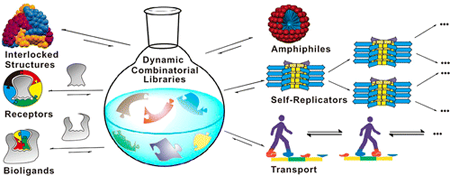Dynamic Combinatorial Libraries
Traditionally the field of synthetic chemistry has focussed on performing a series of thermodynamically downhill reactions to create larger, complex molecules. In contrast, the field of Systems Chemistry takes an evolutionary approach to create complexity by creating a dynamic combinatorial library (DCL), a mixture containing a (large) number of reversibly interchanging building blocks. External or internal influences such as template molecules can drive the DCL far from equilibrium.[1]
The Molecular Dynamics group is interested in modelling the interactions that play a role in determining the outcome of the DCL. A particular example is the reversible formation of macrocycles by dithiol-modified peptides (see Figure). Initially, an equilibrium is formed between a number of different sizes of macrocycles ('species'). Once a critical macrocycle size has been reached and nucleation takes place, a single species of the library can autocatalytically self-replicate by self-assembly into nanostructures.[2] Our aims are to predict the outcome of the DCL by creating a Martini model of the macrocycles that includes reversible covalent chemistry and to clarify the morphology of the nanoscale assemblies by all-atom MD.
This project is executed in collaboration with the Otto lab in the Stratingh Institute for Chemistry.
[1] E. Mattia, S. Otto, Supramolecular systems chemistry, Nat. Nanotechnol. 10, 111–119 (2015)
[2] M. Malakoutikhah, J.J-P. Peyralans, M. Colomb-Delsuc, H. Fanlo-Virgos, M. C. A. Stuart, S. Otto, Uncovering the Selection Criteria for the Emergence of Multi-Building-Block Replicators from Dynamic Combinatorial Libraries. J. Am. Chem. Soc., 135, 18406-18417 (2013)

